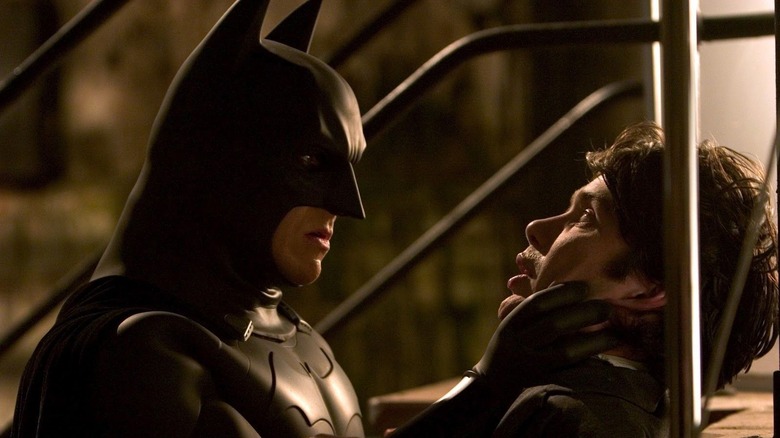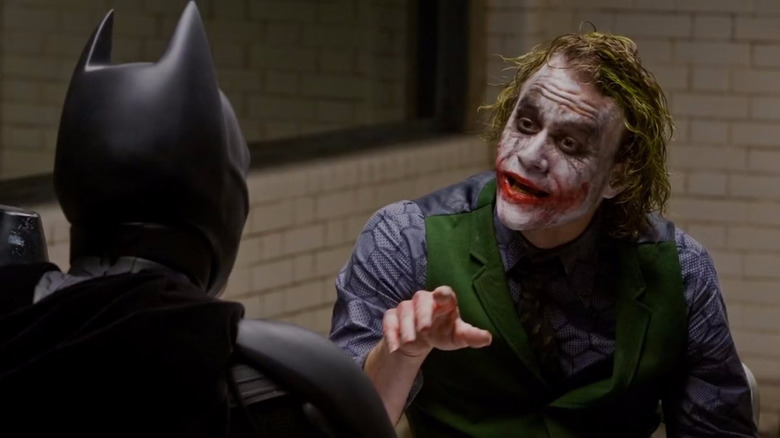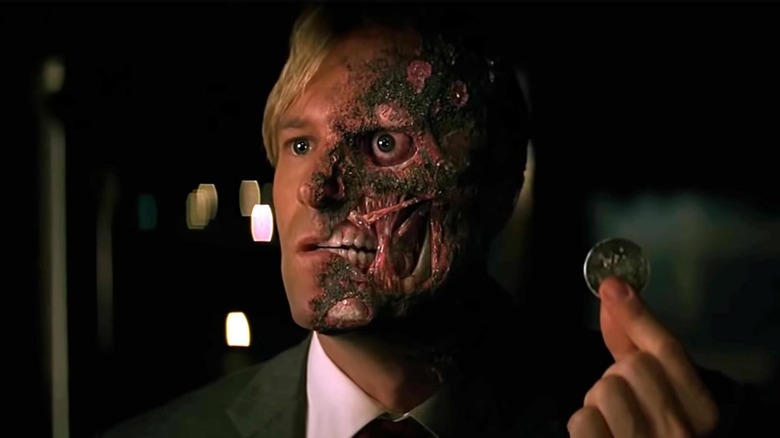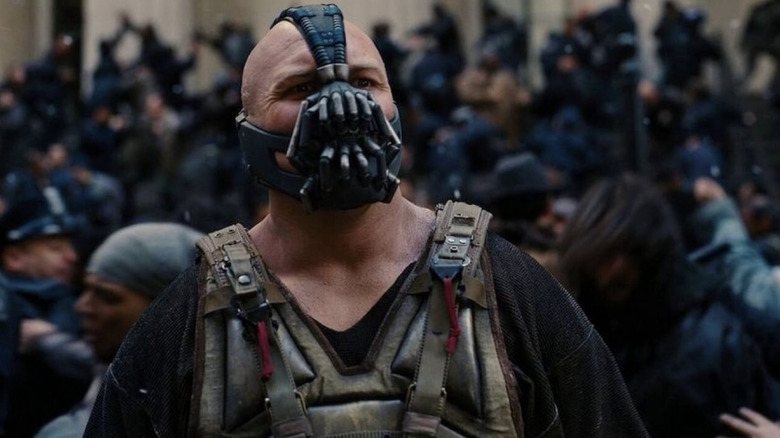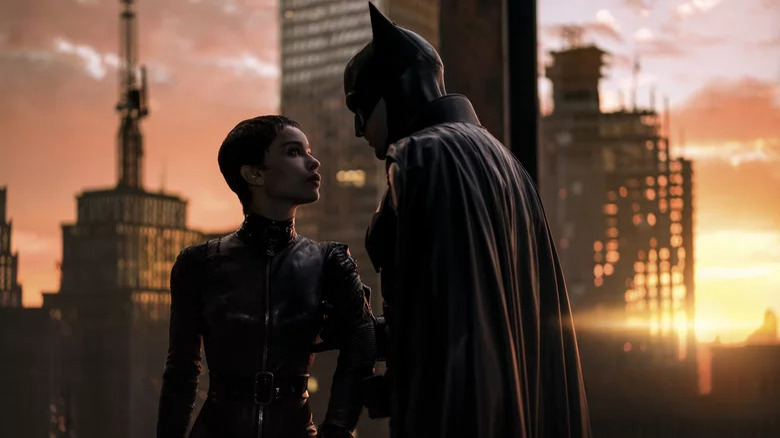How The Dark Knight Team Decided Which Batman Villains The Trilogy Would Tackle
As much as we respect Christopher Nolan for giving his Batman trilogy a clear-cut, definitive ending after only three films, one can't help but wonder what could've happened if there had been four or five movies in total. What other villains could Christian Bale's Batman have gotten to face off against, and what would that have looked like?
It's a juicy, albeit admittedly pointless question, as Nolan was always interested in doing no more than a trilogy, after all. But if a 2020 interview with Nolan and co-writer David S. Goyer is any indication, they would've picked the villain based on what they wanted Bruce Wayne's character arc in the film to be. "With these three films, and with 'Man Of Steel' even, we always said, 'What kind of story do we wanna tell about our protagonist, what kinda challenges do we want to have them face?'" Goyer explained. "And then, 'What character in the rogues' gallery will be best equipped to put our hero through those?'"
That's why "Batman Begins" decided to make Liam Neeson's Ra's al Ghul the main villain of the first film: this movie followed a young Bruce Wayne still reeling from the loss of his parents, and Ra's al Ghul served as "a parental figure," as Goyer put it. Scarecrow (Cillian Murphy), meanwhile, fits in perfectly with the movie's themes of overcoming fear. The themes were always chosen before the villains, not the other way around.
Choosing the Joker and Two-Face
The decision to jump to the Joker in "The Dark Knight" was pretty obvious: not only is he the most famous of Batman's foes, but he falls right into the movie's contemplation on the effects of accelerationism in the war on crime. The regular mob guys originally responsible for most of the crime in Gotham were no match for Batman, but instead of this leading to permanent peace, all it did was breed an even worse brand of criminal. Heath Ledger's Joker was this Batman's first proper supervillain, the first person whose evil plan was hatched as a direct response to Batman's reign. Bruce Wayne's arc in this film is all about him wondering if Gotham truly needs him, which is answered with the sobering realization that it's the Joker who needs him most of all.
Meanwhile, Harvey Dent (Aaron Eckhart) was chosen to complement that arc. Whereas the Joker's very existence serves as a condemnation of what Batman stands for, Dent's downfall serves to highlight why Batman's role is so important. Dent's high-profile job as a legitimate crime-fighter put him under a sanity-breaking level of pressure that Batman's never really had to deal with. Harvey represented hope that Gotham would no longer need someone like Batman to keep Gotham under control, but his downward spiral puts that whole idea into question.
On not bringing Harvey back
"I think people were surprised we killed off Harvey Dent at the end of 'The Dark Knight,'" said David S. Goyer to Empire. "I think they assumed, 'Oh, he'll be the primary villain for the next film' [...] but Chris [Nolan] hates sequel bait."
Sure enough, there was no big reveal in "The Dark Knight Rises" that Two-Face was still alive, just as they never tried to get another actor to play the Joker as some fans speculated. Everything involving both villains was wrapped up within a single movie so that the next would be free to do its own thing. It was a bold move at the time, especially since this wasn't long after comic book movies like "Spiderman 3" and "X-Men: The Last Stand" ran into trouble for trying to juggle too many villains at once. It's easy to imagine a version of "The Dark Knight" where both Two-Face and the Joker felt underbaked, but the movie somehow found just the right balance.
The decision seems even bolder today when most comic book movies seem way more interested in setting up material for sequels down the line. Even "The Batman," which stood on its own more than most, still dedicated significant time in its final act to teasing a potential villain for the sequel. This is something none of Nolan's films ever had any interest in doing. All three movies stood almost entirely on their own. Batman's character arc in each installment was always something new, which would've been complicated if previous villains were still running around.
So, why Bane?
While a more obvious choice would've been a villain like The Riddler or The Penguin, "The Dark Knight Rises" chose to go with the relatively lesser-known Bane. The reasoning this time was simple: Batman would be dealing with a final, existential battle, so he'd need a villain who wanted to end things. Cue the villain who's famous for breaking Batman's spine in the comics.
As great as the Joker was, he was a character who never wanted to kill Batman or destroy Gotham completely. If the Joker had his way, he'd get to continue terrorizing Gotham forever and Batman would always be one step away from catching him. He was basically just trying to reenact "Tom and Jerry" on a much larger scale on a long-term basis. Bane, meanwhile, genuinely wanted to kill Batman and destroy Gotham for good. He was a literal, physical threat in the way that his predecessor never tried to be.
"This is a much more driven character," co-writer Jonathan Nolan said of him. "Bane is a resourceful, cunning, and committed villain who knows exactly what he wants. He wants Batman dead and Gotham in ruins. That's fitting for a third film."
Predicting the next villain
While Christopher Nolan is not involved in Matt Reeves' recent take on the character, the latest live-action Batman film generally seems to take on the same strategy. Paul Dano's Riddler is a vigilante who goes too far in his quest for vengeance, serving as a nice little wake-up call for Rob Pattinson's Batman to not neglect the Bruce Wayne part of his life that keeps him grounded. The Riddler also helps this Batman realize that his job isn't just to punish the bad guys but to protect the innocents, something that the Riddler isn't particularly interested in doing.
While we know we'll never get to see another Nolan-verse Batman villain again, we can at least have fun looking forward to whatever this new series will bring to us. Considering Reeves' Gotham is a lot less grounded in our reality, the pool of potential new villains is much deeper this time around: we could even get to see a live-action Poison Ivy or Mr. Freeze for the first time in decades. Like Nolan's films, however, the surest way to figure out the next villain is to figure out what Batman's next character arc will be. If you can accurately predict what themes the sequel will deal with, and what challenges the writers will want Batman to tackle, you've got a good chance of figuring it out.
